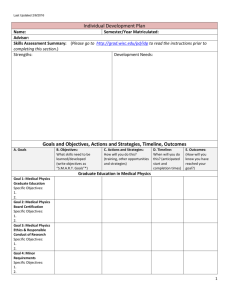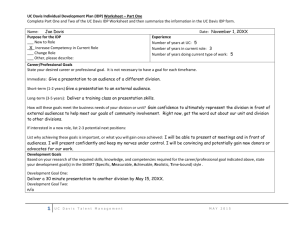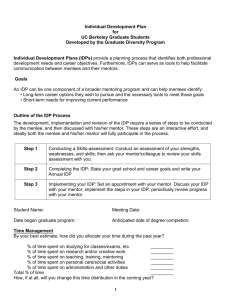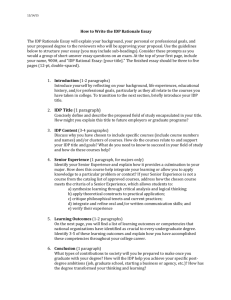Your Guide to Individual Development Planning
advertisement
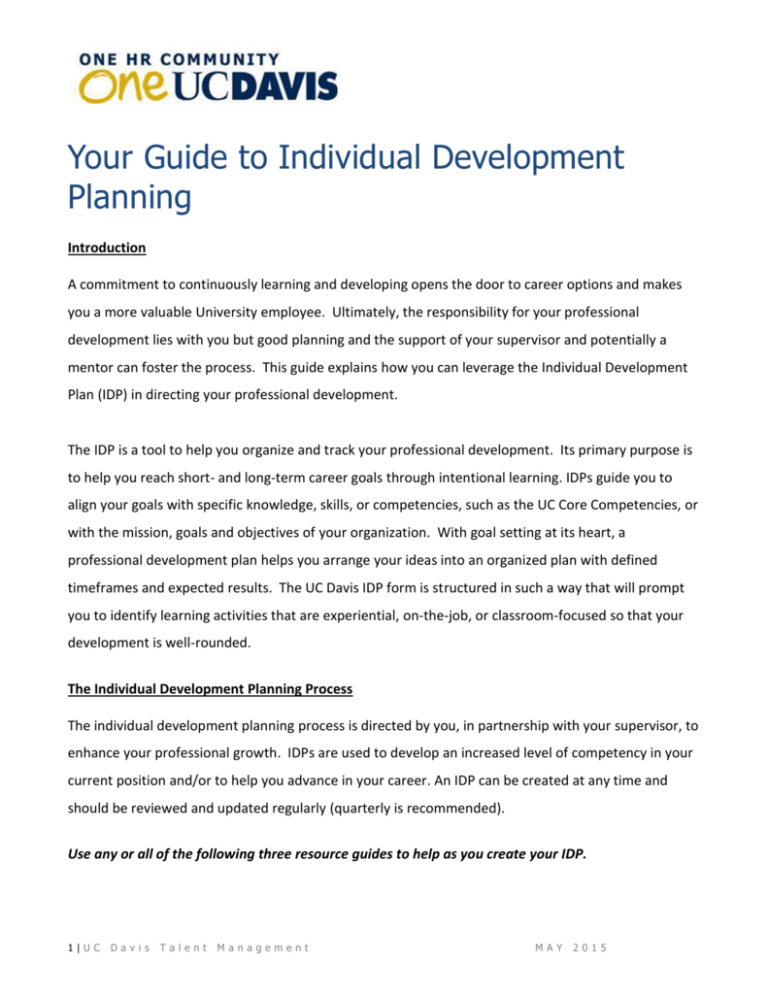
Your Guide to Individual Development Planning Introduction A commitment to continuously learning and developing opens the door to career options and makes you a more valuable University employee. Ultimately, the responsibility for your professional development lies with you but good planning and the support of your supervisor and potentially a mentor can foster the process. This guide explains how you can leverage the Individual Development Plan (IDP) in directing your professional development. The IDP is a tool to help you organize and track your professional development. Its primary purpose is to help you reach short- and long-term career goals through intentional learning. IDPs guide you to align your goals with specific knowledge, skills, or competencies, such as the UC Core Competencies, or with the mission, goals and objectives of your organization. With goal setting at its heart, a professional development plan helps you arrange your ideas into an organized plan with defined timeframes and expected results. The UC Davis IDP form is structured in such a way that will prompt you to identify learning activities that are experiential, on-the-job, or classroom-focused so that your development is well-rounded. The Individual Development Planning Process The individual development planning process is directed by you, in partnership with your supervisor, to enhance your professional growth. IDPs are used to develop an increased level of competency in your current position and/or to help you advance in your career. An IDP can be created at any time and should be reviewed and updated regularly (quarterly is recommended). Use any or all of the following three resource guides to help as you create your IDP. 1|UC Davis Talent Management MAY 2015 Completing the Individual Development Plan Resource Guide Step One – IDP Worksheet Part One Once you have identified your career or professional goals and assessed your skills and knowledge on the related competencies required to meet the goal, you are ready to create your Individual Development Plan (IDP). Part One of the IDP Worksheet is where you will begin to brainstorm and write down your goals. Research shows that you increase your likelihood of obtaining a goal if you write it down and if it is written in a specific format. Part One of the IDP worksheet provides you with a structure for documenting your career or professional goal(s) and your developmental goal(s). Think through your goals, both what you would like to accomplish in a short timeframe and some longer-range goals. Specifically consider what benefits will be achieved from your completing these goals. Write your developmental goals in the SMART style – Specific-Measurable-Achievable-Realistic-Time-bound (see Creating SMART Goals Resource Guide, Page 5 for more information on the SMART style). Start small, perhaps with just one developmental goal, to ensure that you are successful in completing all your selected developmental activities. Step Two – IDP Worksheet Part Two Next, elaborate on each goal by identifying developmental activities. This worksheet helps you brainstorm development activities that will build the skill, knowledge or competencies you targeted in your developmental goal. Research indicates that most learning in the workplace occurs on the job after classroom learning has happened, so resist the urge to devote all of your development to classroom or online learning. An effective IDP includes development activities that include learning by doing, learning from others (such as mentoring, job shadowing), classes, e-learning, and readings. 2|UC Davis Talent Management MAY 2015 Use this worksheet to brainstorm the type of activity you might do and describe specifically how you would do it. Think about the resources you will need to accomplish the activity; perhaps you will need access to a manager to conduct an informational interview, or use Books 24/7 on the UC Learning Center (http://sdps.ucdavis.edu/course_catalog/books_247.html) to access reading material. Each developmental goal should have 2 – 3 developmental activities that you can accomplish in about 12 months. You should focus on a maximum of 3 developmental goals at any one time. To find out what sort of formal training might be available, take a look at the offerings from One UC Davis by going to the UC Learning Center using your Kerberos login. Step Three – UC Davis Individual Development Plan Bring it all together. You’ve brainstormed a lot of ideas and options for development and now you will list the specific developmental activities you will implement. Complete the IDP by transferring select information from Part One and Two of the IDP Worksheets. List specifics, including: Outcomes/Results: Detail what the successful completion of the developmental activity looks like. To do this, answer, “How will you know when the learning you have identified has been accomplished?” Support: Sharing goals with another person increases your likelihood of accomplishing the goal. Share your IDP with someone that can support you by checking-in with you on a regular basis and provide you with feedback. Your supervisor is your best source of support and a mentor can help in this way as well. Target Dates: This is a key component to achieve SMART goals. List specific dates and interim dates, where possible. 3|UC Davis Talent Management MAY 2015 Set reasonable target dates for completion of developmental activities so that you do not become unmotivated or overwhelmed. Start small and enjoy small successes. Status: Use this area of the IDP to note completion of activities or identify potential barriers to be discussed with your supervisor and possibly a mentor who is supporting you with your IDP. Record the date you discuss the plan with your supervisor and set a date for a follow-up meeting. It is important to refresh your IDP often as goals change or new opportunities present themselves. Should you need assistance in completing the UC Davis IDP, please contact Talent Management at sdps@ucdavis.edu OR traininganddevelopment@ucdmc.ucdavis.edu. 4|UC Davis Talent Management MAY 2015 Creating SMART Goals Resource Guide Specific ~ Measurable ~ Achievable ~ Realistic ~ Time-bound Specific A specific goal has a much greater chance of being accomplished than a general goal. To set a specific goal you can answer the six “W” questions: Who: Who is involved? What: What do I want to accomplish? Where: Identify a location. When: Establish a time frame. Which: Identify requirements and constraints. Why: Specific reasons, purpose or benefits of accomplishing the goal. A general goal would be, “Get in shape.” But a specific goal would be to “Join a health club and workout 3 days a week.” EXAMPLE: Decrease department time to complete XYZ process by 10%. Measurable Establishing concrete criteria for measuring progress toward the attainment of each goal you set is key. When you measure your progress, you stay on track, reach your target dates, and experience the exhilaration of achievement that spurs you on to continued effort required to reach your goal. To determine if your goal is measurable, ask questions such as: How much? How many? How will I know when it is accomplished? EXAMPLE: Write a draft proposal with 95% grammatical accuracy. 5|UC Davis Talent Management MAY 2015 Achievable Goals should be written so that they can be accomplished within the timeframe specified. You should design your goals to be a stretch, while still attainable. When you identify goals that are most important to you, you begin to figure out ways you can make them come true. You develop the attitudes, abilities, skills, and capacity to reach them. You can begin seeing previously overlooked opportunities to bring yourself closer to the achievement of your goals. EXAMPLE: Complete the first draft of my IDP by July 30. Realistic To be realistic, a goal must represent an objective towards which you are both willing and able to work. But be sure that every goal represents substantial progress. A high goal is frequently easier to reach than a low one because a low goal exerts low motivational force. Some of the hardest jobs you ever accomplished actually seem easy simply because they were a labor of love. EXAMPLE: Complete the public speaking training within four months. Time-bound A goal should be grounded within a time frame. With no time frame tied to it there’s no sense of urgency. If you want to lose 10 lbs, by when do you want to lose it? “Someday” won’t work. But if you anchor it within a timeframe, “by May 1st”, then you have set your unconscious mind into motion to begin working on the goal. EXAMPLE: Meet with the five department representatives by September 30. 6|UC Davis Talent Management MAY 2015 IDP Planning Steps: Identify – Assess – Plan – Act – Evaluate Resource Guide IDENTIFY The first step in the IDP process is to have a clear picture of your career goals. This includes selfreflection and career exploration to help you identify the career path that will bring you the most job satisfaction. Once you’ve identified your career interest, you can identify the related knowledge, skills, and competencies you need to develop in order to reach your career goal. Check out the UC Davis career management tools and resources available to you as you identify your career goals. Resources available to UC Davis staff include self-assessments, goal setting, and career counseling. You can access any of the resources at: http://sdps.ucdavis.edu/toolkits/career_management/index.html http://sdps.ucdavis.edu/course_catalog/career_management/career_counseling.html http://www.ucdmc.ucdavis.edu/hr/training/ ASSESS Once you have identified the knowledge, skills, and competencies required of your career goal, you will need to assess your current competency in those areas. You may want to review past performance appraisals and feedback you have received from your supervisor or others. Do not focus just on the areas in which you are less skilled, and remember that strengths can also continue to be developed. PLAN The next step is to create the IDP. The Completing the Individual Development Plan Resource Guide (see page 2 of this Guide) provides the step-by-step process for creating the IDP. Once you’ve created your plan, you need to share it with your supervisor and possibly a mentor. You should lead the conversation about your development goals as you are the ultimate owner of your own development, however the plan should be mutually agreed upon by you and your supervisor and possibly a mentor. 7|UC Davis Talent Management MAY 2015 ACT Once your plan is in place, it is time to get busy completing the learning activities by the deadlines you have identified. Individual development often involves changing behaviors in addition to learning new ones. Research suggests that desired change is more likely to be successful when: The desired competency is specifically defined There is commitment and motivation to the behavior change An action plan is shared with others Other people support your behavior change The behavioral outcomes are visible and can be measured Use your calendar to highlight deadlines and schedule time with yourself each week to carry out the learning activities in your plan; a minimum of 30 minutes a week is recommended. Address barriers as they arise and make adjustments to the plan as necessary – remember, this is your individual development plan. EVALUATE Finally, you need to receive feedback on your progress and evaluate your success in meeting your development milestones. Set follow-up meetings with your supervisor and possibly a mentor. The duration and frequency will depend on specific needs but as a general guideline, a 30 minute meeting every three months is recommended. 8|UC Davis Talent Management MAY 2015
